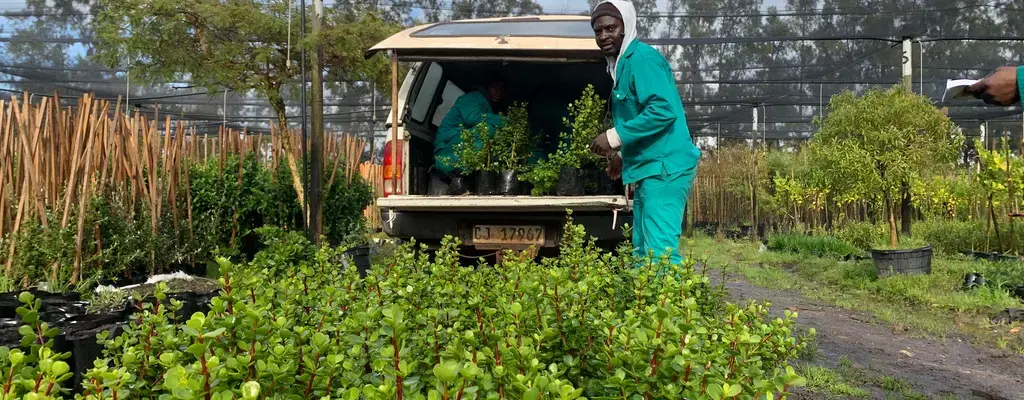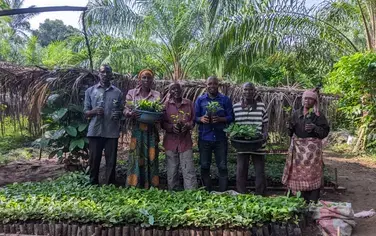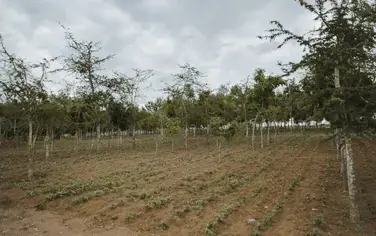Countries are meeting in Madrid, Spain, at the UN Climate Change Conference COP25 to advance in the implementation of the Paris Agreement. Their goal is to beat climate change by dramatically bringing down carbon emissions. Cutting emissions is the only way to secure the planet’s future, but it’s also an opportunity for countries in Africa to promote a sustainable growth that translates into benefits for forests, farmland and other landscapes, and the millions of people that depend on them.
Governments, businesses, non-governmental organizations, communities and organized civil society are uniting to take action on climate now!
African countries are already fihting climate change by restoring forests and landscapes. From Ethiopia to Senegal, and Malawi to Niger, 29 countries have committed to restore more than 125 million hectares of land by 2030, development banks have allocated US$1 billion, and the private sector has pledged to invest $481 million dollars.
This has been possible through AFR100, the African regional contribution to the Bonn Challenge that is bringing together communities, national and subnational governments, the private sectorW and scientists to revive vital ecosystems and create economic opportunities for millions of people in rural areas.
Pledges to restore land are already beginning to be implemented, bringing natural benefits to people like improved agricultural productivity, clean water, and less vulnerability to extreme storms and prolonged droughts. Forest and landscape restoration is much more than just planting trees. It helps remove carbon from the atmosphere by making forests, grasslands, mangroves and other types of land healthy again and disincentivizes deforestation by sustainably managing landscapes through productive activities like silvopasture and agroforestry.
The UN Decades on Family Farming and Ecosystem Restoration – starting in 2019 and 2021, respectively – represent an unparalleled opportunity for people across Africa to increase climate ambition and action by restoring land. Countries are integrating restoration activities and targets into their national adaptation and mitigation strategies. This could have a direct and significant impact for rural communities across Africa by reducing poverty and the impact of land degradation and climate change, three of the UN’s Sustainable Development Goals.
There is still much work to be done, but there are excellent examples to inspire the restoration movement to expand and grow across rural Africa. Policy alignment and investment are crucial, but science, knowledge, data and tools to help implementation are at hand to help along the way. Restoration allows for every sector of society to act against climate change.
Here is how African countries are already taking the lead:
Cameroon

Government leaders from Cameroon explain how they restore land to their Malagasy colleagues.
Restoring land by planting trees and making agriculture more sustainable will be key to meeting Cameroon’s Paris Agreement commitment to fight climate change. Cameroon is poised to become the third member country of AFR100 to deploy a national restoration strategy.
By sharing their experiences reforesting eroded land to protect water sources and collaborating with the Government of Madagascar, Cameroon is on track to restore 12 million hectares and transform the lives of millions of people, mostly farmers. Cameroon’s agencies are working with partners to build their strategy using quality data, which will help build a more effective framework to accelerate restoration.
Ethiopia

In the Tigray region, farmers dig ditches to retain water and protect newly planted trees.
As the climate changes and pressure on the land increase, people living in Ethiopia’s drylands are at risk. In response, Ethiopians planted over 350 million trees in one day, a world record led by the Government—as part of a national pledge to plant four billion trees by 2019. Restoring land has a long history in Ethiopia, where millions of farmers have worked to revitalize over 1 million hectares in the Tigray region.
Planting trees is helping boost farmers’ yields, hold water in the soil, and cool down areas that are getting hotter with climate change, as in the country’s Tigray region. With the Government’s Tree-Based Landscape Restoration Atlas, which helps people decide where to plant, and efforts to build a monitoring framework, Ethiopia is becoming a restoration champion.
Ghana

AFR100 members learn about Ghana’s Youth in Afforestation program in Accra’s Achimota Forest.
Climate change and land degradation together greatly threaten people in Ghana, especially in its dry northern regions. The Government, through its National Forestry Commission’s Youth in Afforestation Programme, is planting trees to make farmers’ land more resilient to climate change and provide timber and energy for communities.
The Government also recently reformed its forest code to incentivize small farmers to plant and care for trees scattered throughout their fields. Ghana is working with technical partners to boost its forest and landscape restoration efforts.
Kenya

Peter Wema, a farmer in Makueni County, Kenya, is investing in restoring his land to protect his country’s water supply.
Climate change is threatening the livelihoods of millions of Kenyans as rainfall patterns become erratic, dramatically putting at risk water supplies. The Kenya Water Towers Agency, tasked with protecting and restoring the country’s water sources by planting trees, is building an online system that enables them to report their successes and pinpoint new activities to protect water. Now, they can show exactly where they are building resilience to climate change throughout the country.
Government agencies have worked with local communities, the private sector, and NGOs to restore heavily degraded landscapes in Makueni County by planting trees and promoting sustainable agriculture. These efforts have helped make land productive, even as the dry season extends because of climate change, connecting farmers to local and international markets and raising incomes. This is an example of effective climate action at the subnational level.
Madagascar

Madagascar’s forests are rich with endemic species, safeguard water, and stabilize the climate for millions of people.
In the past decades, Madagascar has lost millions of hectares of forest and mangroves as population growth and conventional agriculture push into the island’s biodiverse forests. Without forests, communities lose their ability to buffer against the effects of climate change, like warming temperatures and changing rainfall patterns. Through its national restoration strategy, the Government and partners like GIZ are now transforming degraded land into productive and environmentally sound ecosystems that work for people first. For example, in the Boeny Region communities are restoring mangroves, making them more resilient to climate change.
Malawi

Mkandizi Youth Club members take care of saplings in Malawi’s Rumphi District
Malawi’s growing population has put pressure on the land and forests to produce more food and fuelwood. The result is degradation that threatens communities and only worsens as climate change exacerbates extreme weather. Just this year, Cyclone Idai caused severe damage, exacerbated by land degradation, that affected around 2.6 million people.
In response to these challenges, after committing to restore 48% of its total land area as part of AFR100, Malawi became the first country in Africa to develop a National Forest Landscape Restoration Strategy) and a national monitoring framework. To implement that plan, the Government created the Malawi Youth Forest Restoration Programme, a K$1.43 billion (US$2 million) investment to restore 50,000 hectares of land and create jobs for thousands of young people.
Niger

In Niger, millions of people have restored millions of hectares of degraded land, slowing desertification.
In dry Niger, the spread of the Sahara Desert, hastened by climate change, threatens the livelihoods of millions of farmers and their families. A grassroots movement of farmers took action by planting trees and adapting their agricultural practices to the changing climate. In Maradi and Zinder districts alone, farmers restored over 5 million hectares of land. Now, the government, the private sector, and local communities are working together to scale up their success and build sustainable business models with land restoration at their core.
We have only ten years to achieve the world’s goals to restore land and stop deforestation, fight climate change, and ensure that rural communities can develop sustainably. By scaling up the successes of what is already being done across Africa – and investing in new opportunities – countries can reach those goals and create a prosperous future for all.
To learn more about restoration in Africa and through AFR100, please explore our website.




